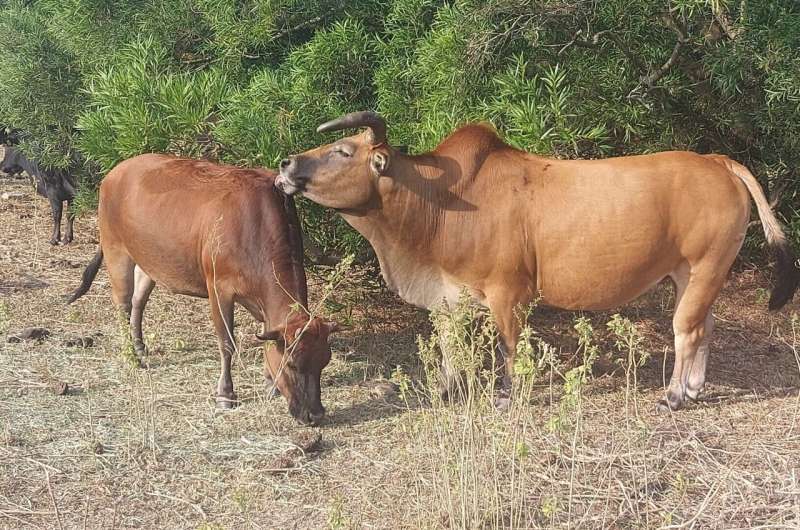This article has been reviewed according to Science X's editorial process and policies. Editors have highlighted the following attributes while ensuring the content's credibility:
fact-checked
peer-reviewed publication
trusted source
proofread
A liking for licking—sex and social status influence social grooming among free-ranging feral cattle in Hong Kong

Unique insights into the social lives of cattle revealed in a new study by scientists at City University of Hong Kong (CityUHK) can enhance our understanding of animal behavior and welfare. The study suggests that sex and social status influence social grooming (where one animal licks another, also known as allogrooming) among free-ranging feral cattle in Hong Kong.
The CityUHK researchers found that feral cattle performed preferential grooming of certain individuals and, in particular, that more dominant females received more grooming. This asymmetrical distribution of licking also applied to whom male cattle decided to lick, according to the study published in Animal Behaviour.
While over a billion cattle are used in production globally, free-ranging feral cattle are relatively unique in Hong Kong, with approximately 900 brown cattle across the region.
"Most research on cattle behaviors is conducted on farms, and so the opportunity to study cattle behavior in free-ranging groups is rare, as there are only a few feral populations worldwide," says Alan McElligott of CityUHK's Department of Infectious Diseases and Public Health in the Jockey Club College of Veterinary Medicine and Life Sciences (JCC).
McElligott co-led the study with Ph.D. researcher George M. W. Hodgson of the Department of Infectious Diseases and Public Health. Other team members include Professor Kate J. Flay and Tania A. Perroux of CityUHK's Department of Veterinary Clinical Sciences, and Dr. Wai Yan Chan, a graduate of JCC's Bachelor of Veterinary Medicine program.
Studying feral cattle social behaviors will aid our understanding of how and why these kinds of friendly behaviors have evolved, adds McElligott, also a member of CityUHK's Centre for Animal Health and Welfare.
The research team conducted observations from February to May 2022 on a mixed-sex cattle herd in Sai Kung East Country Park in Hong Kong and collected data from 47 to 56 cattle per observation day.
The CityUHK team found that all individuals received allogrooming but that not all individuals performed allogrooming. Males performed allogrooming more towards females than other males, but females groomed both sexes equally, suggesting a sex-specific aspect to cattle behavior that is not usually evident when studying them on farms.
Although higher-ranking females (i.e., more dominant animals) received more allogrooming from other individuals than subordinates, no such pattern was found for males. The team also found that high-ranking animals exchanged more friendly grooming between themselves, suggesting that high-ranking females are more attractive as social partners.
"This suggests that grooming isn't directed to higher-ranking animals for exchanging rank-related benefits such as food or protection, as has been found in primates, but rather is used to strengthen social bonds and promote affiliation within the group," said Hodgson.
The team also found that the neck and head were the most commonly groomed regions for the cattle, whereas fewer allogrooming events were performed on the legs and belly.
"Social behaviors such as grooming or dominance are crucial in developing and maintaining herd relationships for farmed and feral cattle," said Professor Flay. "These preferential interactions are important to understand, as they can affect cattle and other ruminants' health, such as parasite burdens and infectious disease transmission."
The takeaway from the study is that these preferential allogrooming patterns improve our knowledge of sex-specific interactions and help us to understand the dynamics of agonistic and affiliative behaviors in multi-male, multi-female, ungulate groups.
"These results are essential for understanding patterns of positive social relationships and what good welfare means for cattle, especially when they are free to choose with whom to interact," said Professor McElligott.
More information: Alan McElligott et al, Animal Behaviour (2024). DOI: 10.1016/j.anbehav.2023.12.020
Journal information: Animal Behaviour
Provided by City University of Hong Kong


















